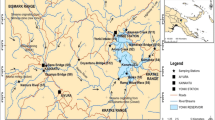Abstract
Mining to obtain ferronickel by the pyrometallurgical process involves a calcination stage that generates a highly metallic solid dust. This study evaluated the bioavailability of metals from calcination dust after being ingested by Oreochromis niloticus. Chemical analysis was performed on the whole body and histological analysis was performed on the gills and gastrointestinal tract of fish to evaluate potential bioaccumulation. After 96 h of exposure to the dust, gill tissue contained a small amount of particulate matter, while the gastrointestinal tract was filled with the material, generating high values of metals in the fish whole body chemical analysis. However, after 15 and 30 days in clean water, both the gills and gastrointestinal tract were nearly devoid of particles and metal concentrations in the fish whole body had largely returned to baseline levels.



Similar content being viewed by others
References
BNDES (2008) BNDES aprova financiamento de R$ 1,4 bilhão para produção de níquel. Available from http://www.bndes.gov.br/noticias/2008/not205_08.asp. Accessed 15 June 2009
Brazil (1965) Decreto No. 55871, de 26 de março de 1965. Modifica o Decreto No. 50040 referente a normas reguladoras do emprego de aditivos para alimentos. Available from http://www.planalto.gov.br/ccivil_03/decreto/1950-1969/D55871.htm Accessed 25 May 2013
Bryan GW (1976) Some aspects of heavy metal tolerance in aquatic organisms. In: Lockwood APM (ed) Effects of pollutants on aquatic organisms. Cambridge University Press, Cambridge, pp 7–34
Burton GA (1991) Assessing the toxicity of freshwater sediments. Environ Toxicol Chem 10:1585–1627
Calmano W, Hong J, Forstner U (1993) Binding and mobilization of heavy metals in contaminated sediments affected by pH and redox potential. Water Sci Technol 28:223–235
Clearwater SJ, Farag AM, Meyer JS (2002) Bioavailability and toxicity of dietborne copper and zinc to fish. Comp Biochem Physiol C Toxicol Pharmacol 132:269–313
Connell DW (1997) Basic concepts of environmental chemistry. CRC Press, Boca Raton
Denny P, Bailey R, Tukahirwa E, Mafabi P (1995) Heavy metal contamination of Lake George (Uganda) and its wetlands. Hydrobiologia 297:229–239
Evans DH, Piermarini PM, Choe KP (2005) Multifunctional fish gill: dominant site gas exchange, osmoregulation, acid-base regulation, and excretion of nitrogenous waste. Physiol Rev 85:97–177
FAO/WHO (2011) Working document for information and use in discussions related to contaminants and toxins in the GSCTFF. CF/5 INF/1, Mar 2011
Gupta CK (2002) Chemical metallurgy: principles and practice. Wiley, Weinhein
Haroon AKY, Pittman KA, Blom G (1998) Diel feeding pattern and ration of two sizes of tilapia, Oreochromis spp. in pond and paddy field. Asian Fish Sci 10:281–301
Lottermoser BG (2007) Mine wastes: characterization, treatment and environmental impacts. Springer, Berlin
Low KH, Zain SM, Abas MR (2011) Evaluation of metal concentrations in red tilapia (Oreochromis spp) from three sampling sites in Jelebu, Malaysia using principal component analysis. Food Anal Methods 4:276–285
Luoma SN (1983) Bioavailability of trace metals to aquatic organisms—a review. Sci Total Environ 28:1–22
Meurer F, Hayashi C, Boscolo WR (2003) Digestibilidade aparente de alguns alimentos protéicos pela Tilápia do Nilo (Oreochromis niloticus). Rev Bras Zootec 32:1801–1809
Ojo AA, Wood CM (2007) In vitro analysis of the bioavailability of six metals via the gastro-intestinal tract of the rainbow trout (Oncorhynchus mykiss). Aquat Toxicol 83:10–23
Oliveira-Filho EC, Muniz DHF, Ferreira MFN, Grisolia CK (2010) Evaluation of acute toxicity, cytotoxicity and genotoxicity of a nickel mining waste to Oreochromis niloticus. Bull Environ Contam Toxicol 85:467–471
Schlekat CE, Decho AW, Chandler GT (2000) Bioavailability of particle associated silver, cadmium and zinc to the estuarine amphipod Leptocheirus plumulosus through dietary ingestion. Limnol Oceanogr 45:11–21
Smith BJ, Smith SA, Tengjaroenkul B, Lawrence TA (2000) Gross morphology and topography of the adult intestinal tract of the tilapian fish, Oreochromis niloticus L. Cells Tissues Organs 166:294–303
Tengjaroenkul B, Smith BJ, Caceci T, Smith SA (2000) Distribution of intestinal enzyme activities along the intestinal tract of cultured Nile tilapia, Oreochromis niloticus L. Aquaculture 182:317–327
Acknowledgments
We thank CT-Mineral CNPq of the Brazilian Ministry of Science and Technology (Project No. 409997/2006-4) and SEG-Embrapa for financial support. Laís de Souza Lima received a fellowship from UniCEUB/PIBIC/CNPq.
Author information
Authors and Affiliations
Corresponding author
Rights and permissions
About this article
Cite this article
Oliveira-Filho, E.C., Lima, L.S., Muniz, D.H.d. et al. Bioavailability Assessment of Metals from a Nickel Mining Residue in the Gastrointestinal Tract of Oreochromis niloticus In Vivo. Bull Environ Contam Toxicol 91, 533–538 (2013). https://doi.org/10.1007/s00128-013-1085-5
Received:
Accepted:
Published:
Issue Date:
DOI: https://doi.org/10.1007/s00128-013-1085-5




